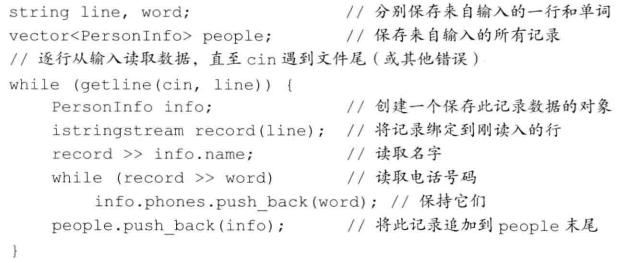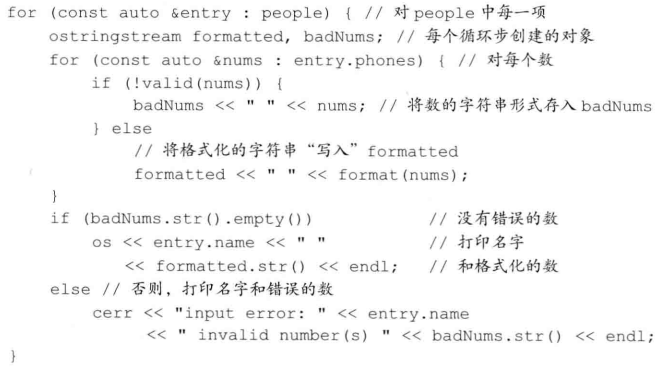C++中的输入参考
1、输入输出
1)operator>>
参考:cplusplus.com
Extracts characters from is and stores them in s as a c-string, stopping as soon as either a whitespace character is encountered or (width()-1) characters have been extracted (if width is not zero).
A null character (charT()) is automatically appended to the written sequence.
Internally, the function accesses the input sequence of is by first constructing a sentry with noskipws set to false: this may flush its tied stream and/or discard leading whitespaces (see istream::sentry).
// example on extraction
#include <iostream> // std::cin, std::cout
int main () {
char str[10];
std::cout << "Enter a word: ";
std::cin.width (10); // limit width
std::cin >> str;
std::cout << "The first 9 chars of your word are: " << str << '\n';
return 0;
}
2)getline()
参考:cplusplus.com
Extracts characters from is and stores them into str until the delimitation character delim is found.
Note that any content in str before the call is replaced by the newly extracted sequence.
参考:cppreference.com
When used immediately after whitespace-delimited input, e.g. after int n; std::cin >> n;, getline consumes the endline character left on the input stream by operator>>, and returns immediately. A common solution is to ignore all leftover characters on the line of input with cin.ignore(std::numeric_limitsstd::streamsize::max(), '\n'); before switching to line-oriented input.
#include <iostream>
#include <string>
using namespace std;
int main()
{
cout << "Please enter an integer: ";
int number;
cin >> number; // put user input in number
cout << "What is your name? ";
cin.ignore(); // Don't use getline after cin >> without using ignore!
string name;
getline(cin, name, '\n'); // put user input in name
cout << "Thank you, " << name << ". " << endl;
cout << "Your number is " << number << "." << endl;
return 0;
}
3)cin.getline()
参考:cplusplus.com
The delimiting character is the newline character ('\n') for the first form, and delim for the second: when found in the input sequence, it is extracted from the input sequence, but discarded and not written to s.
A null character ('\0') is automatically appended to the written sequence if n is greater than zero, even if an empty string is extracted.
参考:cppreference.com
Extracts characters from stream until end of line or the specified delimiter delim.
// istream::getline example
#include <iostream> // std::cin, std::cout
int main () {
char name[256], title[256];
std::cout << "Please, enter your name: ";
std::cin.getline (name,256);
std::cout << "Please, enter your favourite movie: ";
std::cin.getline (title,256);
std::cout << name << "'s favourite movie is " << title;
return 0;
}
注意,cin.getline()属于istream流,而getline()属于string流,getline()的第一个参数是cin,两个函数是不一样的;它们也有共同点,即都可以有第3个用于分隔的参数(默认是'\n')。
详细请参考:Tips and tricks for using C++ I/O (input/output)、C++中cin、cin.get()、cin.getline()、getline()、gets()等函数的用法。
2、基本类型与字符串之间的转换
1)itoa()
参考:cplusplus.com
Converts an integer value to a null-terminated string using the specified base and stores the result in the array given by str parameter.
This function is not defined in ANSI-C and is not part of C++, but is supported by some compilers.
/* itoa example */
#include <stdio.h>
#include <stdlib.h>
int main ()
{
int i;
char buffer [33];
printf ("Enter a number: ");
scanf ("%d",&i);
itoa (i,buffer,10);
printf ("decimal: %s\n",buffer);
itoa (i,buffer,16);
printf ("hexadecimal: %s\n",buffer);
itoa (i,buffer,2);
printf ("binary: %s\n",buffer);
return 0;
}
2)atof(), atoi(), atol()
/* atoi example */
#include <stdio.h> /* printf, fgets */
#include <stdlib.h> /* atoi */
int main ()
{
int i;
char buffer[256];
printf ("Enter a number: ");
fgets (buffer, 256, stdin);
i = atoi (buffer);
printf ("The value entered is %d. Its double is %d.\n",i,i*2);
return 0;
}
3)itoa()区别于iota()
// iota example
#include <iostream> // std::cout
#include <numeric> // std::iota
int main () {
int numbers[10];
std::iota (numbers,numbers+10,100);
std::cout << "numbers:";
for (int& i:numbers) std::cout << ' ' << i;
std::cout << '\n';
return 0;
}
4)strtod(), strtol()
参考:cplusplus.com
The function first discards as many whitespace characters as necessary until the first non-whitespace character is found. Then, starting from this character, takes as many characters as possible that are valid following a syntax that depends on the base parameter, and interprets them as a numerical value. Finally, a pointer to the first character following the integer representation in str is stored in the object pointed by endptr.
/* strtol example */
#include <stdio.h> /* printf */
#include <stdlib.h> /* strtol */
int main ()
{
char szNumbers[] = "2001 60c0c0 -1101110100110100100000 0x6fffff";
char *pEnd;
long int li1, li2, li3, li4;
li1 = strtol (szNumbers,&pEnd,10);
li2 = strtol (pEnd,&pEnd,16);
li3 = strtol (pEnd,&pEnd,2);
li4 = strtol (pEnd,NULL,0);
printf ("The decimal equivalents are: %ld, %ld, %ld and %ld.\n", li1, li2, li3, li4);
return 0;
}
注意,itoa()与strtol()需要一个参数作为转换的基数。
4)sprintf()
参考:cplusplus.com
Composes a string with the same text that would be printed if format was used on printf, but instead of being printed, the content is stored as a C string in the buffer pointed by str.
On success, the total number of characters written is returned. This count does not include the additional null-character automatically appended at the end of the string.
/* sprintf example */
#include <stdio.h>
int main ()
{
char buffer [50];
int n, a=5, b=3;
n=sprintf (buffer, "%d plus %d is %d", a, b, a+b);
printf ("[%s] is a string %d chars long\n",buffer,n);
return 0;
}
5)sscanf()
Reads data from s and stores them according to parameter format into the locations given by the additional arguments, as if scanf was used, but reading from s instead of the standard input (stdin).
On success, the function returns the number of items in the argument list successfully filled. This count can match the expected number of items or be less (even zero) in the case of a matching failure.
/* sscanf example */
#include <stdio.h>
int main ()
{
char sentence []="Rudolph is 12 years old";
char str [20];
int i;
sscanf (sentence,"%s %*s %d",str,&i);
printf ("%s -> %d\n",str,i);
return 0;
}
3、分隔字符串
1)strtok()
参考:cppreference.com
Finds the next token in a null-terminated byte string pointed to by str. The separator characters are identified by null-terminated byte string pointed to by delim.
This function is designed to be called multiples times to obtain successive tokens from the same string.
参考:cplusplus.com
This end of the token is automatically replaced by a null-character, and the beginning of the token is returned by the function.
Once the terminating null character of str is found in a call to strtok, all subsequent calls to this function (with a null pointer as the first argument) return a null pointer.
#include <cstring>
#include <iostream>
int main()
{
char input[100] = "A bird came down the walk";
char *token = std::strtok(input, " ");
while (token != NULL) {
std::cout << token << '\n';
token = std::strtok(NULL, " ");
}
}
注意,该函数第一次调用时的参数和以后调用的参数是不同的,它可以搭配cin.getline()一起使用。
2)istringstream, ostringstream, stringstream
stringstream同时具有前两者的功能。
假设输入为

数据结构为

先用istringstream处理

再用ostringstream处理

3)string::find()
void split(const string& str, char delimiter, vector<string>& result) {
auto i = 0;
auto pos = str.find(delimiter);
while (pos != string::npos) {
result.push_back(str.substr(i, pos-i));
i = ++pos;
pos = str.find(delimiter, pos);
if (pos == string::npos)
result.push_back(str.substr(i, str.length()));
}
}
详细请参考:Split a string using C++、C++常见问题: 字符串分割函数 split。
注意,istringstream和stringstream可以搭配getline()一起使用。
C++中的输入参考的更多相关文章
- Shell脚本中判断输入参数个数的方法投稿:junjie 字体:[增加 减小] 类型:转载
Shell脚本中判断输入参数个数的方法 投稿:junjie 字体:[增加 减小] 类型:转载 这篇文章主要介绍了Shell脚本中判断输入参数个数的方法,使用内置变量$#即可实现判断输入了多少个参数 ...
- python利用Trie(前缀树)实现搜索引擎中关键字输入提示(学习Hash Trie和Double-array Trie)
python利用Trie(前缀树)实现搜索引擎中关键字输入提示(学习Hash Trie和Double-array Trie) 主要包括两部分内容:(1)利用python中的dict实现Trie:(2) ...
- ChemDraw中如何输入化学式分隔点
ChemDraw最实用的化学结构绘图软件,在绘制化学结构时,离不开给化学结构标记原子名称,有时还需要插入分隔点,本教程以下图给出的化学结构为例,讲解ChemDraw中如何输入化学式分隔点. 化学结构 ...
- C#中实现输入汉字获取其拼音(汉字转拼音)的2种方法
主要介绍了C#中实现输入汉字获取其拼音(汉字转拼音)的2种方法,本文分别给出了使用微软语言包.手动编码实现两种实现方式,需要的朋友可以参考下 本文刚发布时,只写了一个实现方式,使用的是微软的语言包,但 ...
- MathType中如何输入正、余弦函数
MathType是一款强大的数学公式编辑器,正.余弦函数也是中学中非常重要的一节知识点,今天我们介绍一下在MathType中怎么输入正.余弦函数. 具体步骤如下: 步骤一 打开专业的公式编辑软件Mat ...
- 控制input标签中只能输入数字以及小数点后两位
js 代码如下: /* 控制input标签中只能输入数字 和小数点后两位 */ function checkNum(obj) { //检查是否是非数字值 if (isNaN(obj.value)) { ...
- 关于Eclipse中校验输入文件名的源代码
Eclipse中测试文件名的方法. 也没有单独的分操作系统.在Talend时解决一个在文本框中输入名字有Bug的一个问题,这个是Eclipse中解决输入名字,对名字校验的部分源码. public IS ...
- textarea中限制输入字符长度
要在textarea中限制输入字符的长度,比如在twitter中要限制字符为140个,可实现的方法有: 1. <textarea name="A" cols="45 ...
- Android中TextView输入字数统计和限制
在Android开发应用的时候,文本编辑框中最多输入140个字,经常会显示还剩多少字以限制用户输入的字数, EditText content;//定义一个文本输入框 TextView hasnum;/ ...
随机推荐
- HDU 5569 matrix
简单DP /* *********************************************** Author :Zhou Zhentao Email :774388357@qq.com ...
- HDU 5534 完全背包
Partial Tree Time Limit: 2000/1000 MS (Java/Others) Memory Limit: 262144/262144 K (Java/Others)To ...
- JAVA基础---面向对象
方法的重载Overload: 一个类中可以定义有相同的名字, 参数不同的多个方法. 调用时, 会根据不同的参数选择对应的方法. static: 在数据区, 可以计数,属于类,不属于对象: public ...
- Counting Intersections
Counting Intersections Time Limit: 12000/6000 MS (Java/Others) Memory Limit: 65536/65536 K (Java/ ...
- 整理JRE瘦身或精简JRE
http://blog.csdn.net/xiaoping8411/article/details/6973887 版权声明:本文为博主原创文章,未经博主允许不得转载. 前不久给朋友做了一个桌面程序, ...
- 关于Discuz与jQuery冲突问题的亲测解决方法
最近的一个项目整合dede和discuz程序,客户要求风格统一,所以有很多样式及特效都是要公用的.其中jQuery库定义的函数$()正好与discuz的comme.js中函数一样,这样就冲突了,导致d ...
- LWIP裸机环境下实现TCP与UDP通讯
前面移植了LWIP,并且简单的实用了DHCP的功能,今天来使用一下实际的数据通讯的功能 首先是实现TCP客户端,我先上代码 #ifndef __TCP_CLIENT_H_ #define __TCP_ ...
- iOS调试-LLDB学习总结
from:http://www.jianshu.com/p/d6a0a5e39b0e LLDB阐述 LLDB 是一个有着 REPL 的特性和 C++ ,Python 插件的开源调试器.LLDB 绑定在 ...
- stm单片机之STM32F4-Discovery资料汇总 (转载自http://blog.163.com/thinki_cao/blog/static/83944875201362493134992/)
STM32F4的资料大部分都在这里: http://www.stmcu.org/download/index.php?act=ziliao&id=150 根据个人的理解对这些资料作了一些规律, ...
- IOS web app一些实用的属性设置
IOS对safari私有的属性很多,虽然很多不为人知但是却很实用.掌握好这些属性对web app和混合app的开发会很有帮助. 1.format-detection[telephone=no] 是否自 ...
